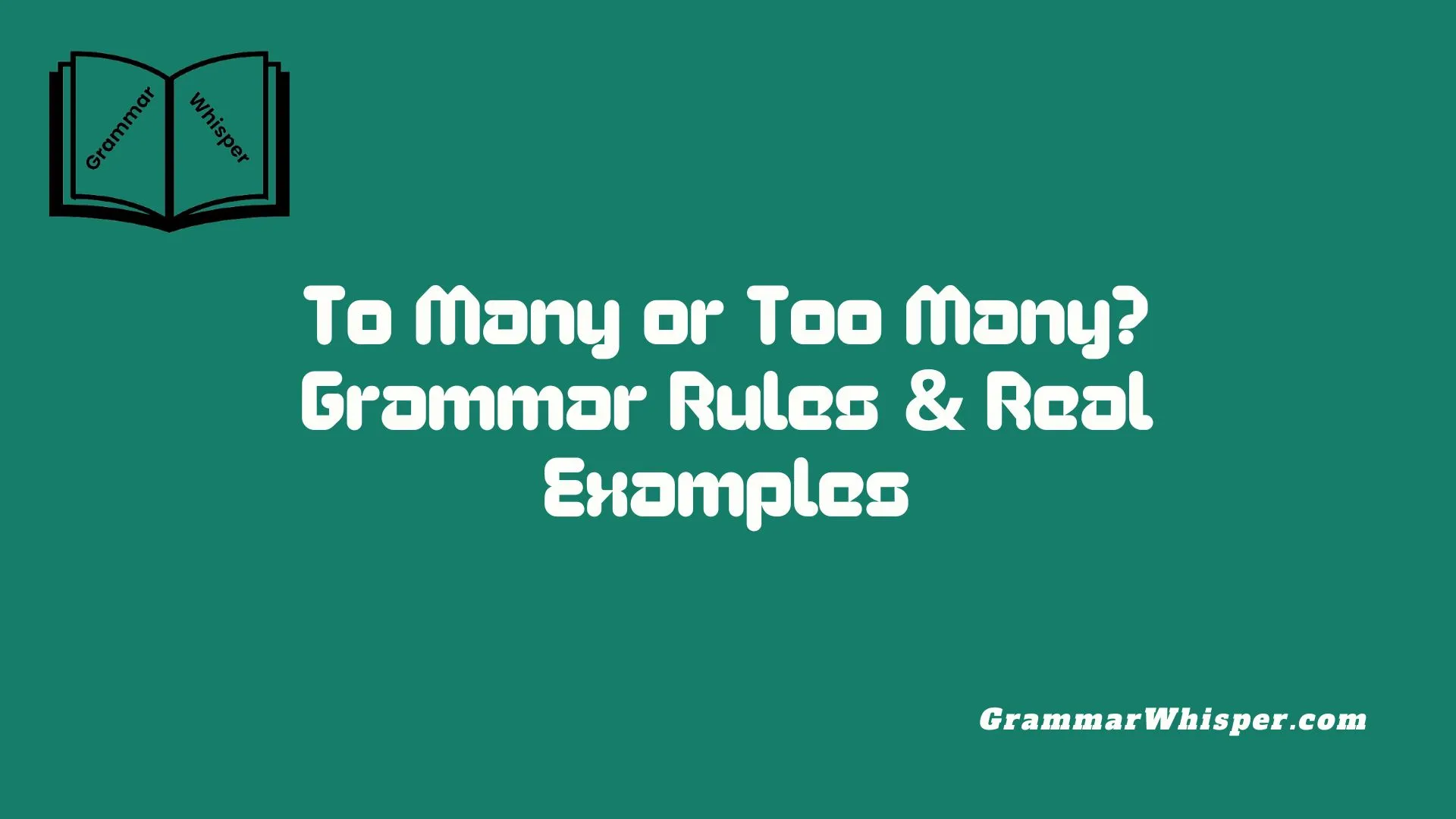As someone who’s edited countless emails, essays, and published content, I’ve seen how common the mix-up between “To Many or Too Many” can be. One tiny letter – just a single vowel – can shift a correct sentence into something that feels awkward or even confusing. I’ve second-guessed phrases like “to many people” during proofreading, only to spot they were actually mistakes. The good news is, once you truly understand the grammar and meaning behind each word, it gets easier to spot and fix those errors with confidence.
In this in-depth guide, you’ll learn that “too many” refers to an excessive quantity or number of amounts – so it’s the right choice when talking about numbers. “To many” might seem acceptable when written, but unless you’re literally speaking to many people, it doesn’t fit. With real-life examples, usage tables, and quick grammar breakdowns, I’ve helped many writers remember the difference using clear tips. Mastering this small detail has improved my writing and saved countless hours of editing.
Understanding the Real Difference Between “Too” and “To”
At first glance, they seem interchangeable. But they’re functionally different in English grammar.
Too
Part of speech: Adverb Meaning: More than enough or also
🔹 Examples:
- “She has too much work today.”
- “I’d like to come too.”
To
Part of speech: Preposition or infinitive marker Meaning: Indicates direction, recipient, or intention
🔹 Examples:
- “He went to the store.”
- “Give the book to Sarah.”
- “I want to go home.”
➡️ So when you’re describing an excessive quantity, you’re not talking about direction, you’re talking about degree. That’s where “too many” fits in.
Why “Too Many” Is the Only Correct Phrase for Quantity
“Too many” is a standard phrase in English grammar used to express an excessive number of countable items.
Grammar Structure:
Too (adverb) + Many (quantifier) + Countable noun
This combination always points to an overwhelming or undesirable amount of something.
🔹 Examples:
- “There are too many cars on the road.”
- “I ate too many cookies.”
- “She gets too many emails every day.”
💡 Use “too many” when:
- You’re talking about things you can count
- The number is excessive or problematic
It communicates a negative degree – there’s more than necessary or manageable.
Why “To Many” Isn’t Technically Wrong, But Rarely Right
“To many” isn’t a grammatical error – it just doesn’t mean what most people think it means.
Let’s unpack it:
“To” is a preposition “Many” is a quantifier (used to describe countable groups)
Together, “to many” usually appears in phrases like:
- “He spoke to many of his colleagues.”
- “The letter was addressed to many of the team members.”
- “She gave gifts to many children.”
💡 In all these examples, “to many” indicates the direction or recipient of an action, not quantity.
“Too Many” vs. “To Many”: A Side-by-Side Comparison
To clarify the difference, here’s a quick-reference grammar table:
| Phrase | Function | Meaning | Example | Correct for Quantity? |
| Too many | Adverb + Quantifier | Excessive number of countable nouns | “There are too many meetings.” | ✅ Yes |
| To many | Preposition + Group Quantifier | Indicates action directed toward many | “He spoke to many students.” | ❌ No (not for quantity) |
How Context Dictates the Correct Phrase
Context is your best friend in choosing the right expression.
Look at the verb:
- Is it about doing something to someone or a group? → To many
- Is it about having too much of something? → Too many
🔍 Real-world comparisons:
| Sentence | Phrase Used | Correct? | Why |
| “She apologized to many of her coworkers.” | To many | ✅ | Prepositional phrase showing direction |
| “He made to many mistakes.” | To many | ❌ | Should be “too many” – quantity is excessive |
| “They donated to many shelters.” | To many | ✅ | Refers to recipients |
| “We received to many emails.” | To many | ❌ | Should be “too many” – countable noun overload |
The Role of Quantifiers: How “Many” Works in English
Quantifiers tell us how much or how many of something exists.
“Many” is a quantifier used only with countable nouns – nouns that can be counted individually.
Common countable nouns:
- Books
- People
- Mistakes
- Emails
- Chairs
- Dollars
When the number of those countable things becomes overwhelming, we say “too many”.
Countable vs. Uncountable Nouns: Key to Proper Usage
Understanding countability helps you know whether to use “too many” or “too much.”
Here’s a useful breakdown:
| Use “Too Many” With (Countable) | Use “Too Much” With (Uncountable) |
| Bananas | Water |
| Friends | Stress |
| Deadlines | Time |
| Shoes | Information |
| Emails | Sugar |
💡 Remember:
- If you can make it plural (e.g., books → books), it’s countable.
- If not, it’s likely uncountable (e.g., advice, equipment, knowledge).
Common Mistakes and Why They Happen
Mistaking “to many” for “too many” is surprisingly easy. Here’s why:
✅ Top causes:
- Auto-correct fails on phones or word processors
- Speech-to-text confusion (especially in American and British accents)
- Visual similarity – only one extra “o”
- Lack of grammar awareness – especially among ESL learners
❌ Examples of incorrect usage:
- “There are to many errors in this report.”
- “He works to many hours a day.”
- “She invited to many people.”
These are all incorrect – and all should say “too many.”
Tips to Remember the Difference Between “To” and “Too”
Don’t let one letter trip you up. Try these memory tricks:
Easy Mnemonics:
- Too = Extra O = Extra amount
- If it means more than enough, you need the extra “o”
Analogy:
Think of “too many” as a cup overflowing. The extra “o” represents the overflow. Whereas “to many” is like a direction sign – pointing the action to someone.
Practice tip:
If you can replace the word with “also” or “excessively”, you probably want “too”.
When “To Many” Is Actually Correct: Legitimate Grammar Uses
Let’s be fair – “to many” isn’t always a mistake.
Valid Use Cases:
- “The CEO wrote a letter to many of the shareholders.”
- “She spoke kindly to many during the campaign.”
- “The gift was sent to many of the participants.”
In these examples, “to many” describes the recipient of an action – not the quantity of the noun.
How Native Speakers Use “Too Many” Naturally
You’ll find “too many” all over real speech and writing – especially when people feel overwhelmed, frustrated, or critical.
Examples from Everyday English:
- “There are too many commercials during this show.”
- “I have too many things to do.”
- “There are too many cooks in the kitchen.”
It adds emphasis to a negative or overloaded experience.
Pronunciation Tips: Don’t Let the Sound Trick You
“Too” and “to” are homophones in many English accents – they sound the same.
This makes them hard to distinguish in:
- Speech-to-text dictation
- Informal speaking
- Non-native pronunciation
💡 Tip: Slow down and consider meaning – not sound – when writing.
Correct Usage in Formal Writing, Emails, and Exams
In formal writing, like academic papers or professional emails, using the wrong form can weaken your credibility.
Example:
- ❌ “There are to many grammatical errors in this document.”
- ✅ “There are too many grammatical errors in this document.”
🧠 Grammar tip: Always run a quick grammar check when using “to” or “too” – especially in situations that affect your grade, job, or reputation.
Quick Grammar Exercises to Test What You’ve Learned
Try filling in the blanks with “to” or “too”:
- She has ___ many assignments to finish before Friday.
- He gave instructions ___ many of the volunteers.
- There were ___ many distractions in the room.
- Letters were sent ___ many customers as a courtesy.
- I’m ___ tired to keep going.
Answers:
- Too
- To
- Too
- To
- Too
Conclusion
Let’s wrap this up clearly:
- Use “too many” when talking about an excessive number of countable things
- Use “to many” only when you’re referring to a direction or recipient
- One vowel changes the meaning, the tone, and the correctness of your sentence
The next time you write one of these phrases, pause for half a second. Ask: 👉 Am I talking about excess or direction? That one thought will help you choose the right phrase every time.
FAQs
Is it “to many” or “too many”?
Too many is correct when you’re talking about excessive quantity. “To many” is only correct when referring to a direction or recipient, like “He gave gifts to many people.”
Why is “too many” used for countable nouns only?
Because “many” modifies countable nouns. For uncountable nouns, we use “too much” (e.g., too much noise, too much work).
Can “to many” ever be grammatically correct?
Yes. It can be correct in prepositional phrases. For example: “She donated books to many libraries.”
How can I remember when to use “too” or “to”?
Think of “too” as meaning “excessively” or “also” – it has an extra ‘o’ for a reason. “To” is usually about direction or a recipient.
What’s the most common mistake people make with these phrases?
Typing “to many” when they mean “too many” – often due to autocorrect or thinking of how the word sounds instead of its grammar role.











